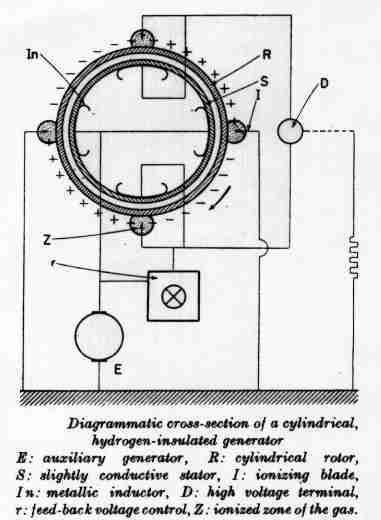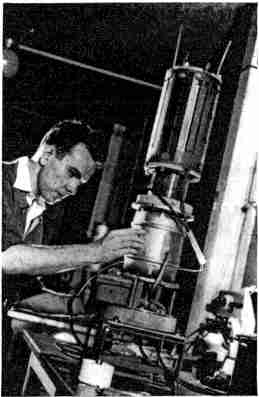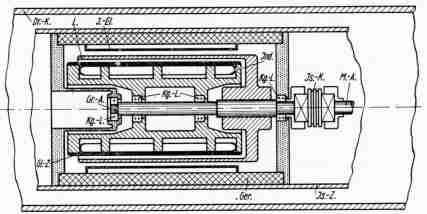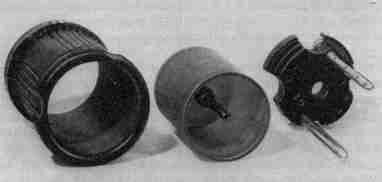GENERATEUR ELECTROSTATIQUE FELICI
(Felici's electrostatic generator )
 |
 |
| fig 1 Cross section of a cylindrical Felici's generator | fig 2 Generator under which is driving motor |
GENERATEUR ELECTROSTATIQUE FELICI
(Felici's electrostatic generator )
 |
 |
| fig 1 Cross section of a cylindrical Felici's generator | fig 2 Generator under which is driving motor |
En France,entre 1945 et 1960, le laboratoire d'Electrostatique du Centre National de la Recherche Scientifique , CNRS, s'est attache a une etude systematique des generateurs electrostatiques, afin d'en tirer la maximum au point de vue energetique, et d'en permettre l'emploi dans les applications courantes ( rayons X , peinture electrostatique, essais electriques, etc.). Ces recherches ont conduit a un modele assez different de la machine a courroie ( Van de Graaff) , car l'organe mobile est ici un cylindre creux, et le gaz comprime d'isolement est de l'hydrogene pur.
Le generateur electrostatique de NoŽl FELICI est celui qui permet les experiences spectaculaires d'electrostatique du PALAIS de la DECOUVERTE a PARIS.
La SAMES, Societe anonyme de Machines Electrostatiques, creee en 1947, a developpe pour le CNRS ( physique des particules , physique nucleaire) ces generatrices electrostatiques de grande puissance, de faible encombrement et de bon rendement .
Sames was created in 1947 to manufacture and market the electrostatic generators developed by Pr Noel Felici and his team for the french National Center for Scientific Research ( CNRS) .These continuous HV generators quickly gained a significant position in most research centers, as well as in industry,because of their exceptional levels of performance safety
La generatrice utilise un transporteur isolant cylindrique (composite epoxy) R [fig 1] Les dimensions du tambour sont classiquement de 140 mm de diametre ( et jusqu'a 300 mm ), 220 mm de longueur, 0.3 mm d'epaisseur.Les electrodes ( ionisateur de charge et ionisateur de debit) sont disposees le long de generatrices diametralement opposees.L'ensemble est place dans une enceinte d'hydrogene sous pression. Ni la disposition cylindrique , ni l'hydrogene ne sont tres favorables a l'obtention de tensions tres elevees; en revanche, la puissance specifique et le rendement sont superieurs a ceux de toous les autres generateurs electrostatiques.La forme cylindrique assure une excellente definition geometrique de la machine qui est ainsi tres compacte. Les tensions sont de 80 a 750 kV et les courants de l'ordre de 0,2 a 14 mA.
The Felici generators ( SAMES) of the ' insulating carrier ' type convert mechanical energy directly into DC HV electrical energy by utilizing the charge (ion) transfer effect in an electric field.
The generator unit is comprised of 3 main parts :
Insulating cylindrical rotor [R], a hollow cylinder made of insulating material. Electric charges are deposited on the surface of the rotor which is generally driven by an electric motor to effect the transfer of charges in, the field. This is the only moving part in the generator.For the standard running speed of 3,000 r.p.m, the maximum rotor diameter is 15 to 18 in.The useful length of the rotor (i.e., the length of the ionising blades) may not overstep 1.5 times its diameter for the "bell" geometry; with the "drum" rotor, however, 2.5 diameters is a conservative value. Then, for rotors of 12 to 15 in., a useful length of 3 ft seems very reasonable, that is, a useful surface of, say, 104 cm2.
Ionizers, extremely thin metallic blades placed in close proximity to the rotor. The charging ionizers generate and deposit the electric charges while the discharging ionizers draw off the charges that have been carried on the surface of the rotor.
Metallic inductors. The purpose of the inductors is to induce a strong electric field on the sharp edge of the ionizers.Excitation inductors hold the electric charges on the rotor, whereas the extracting inductors withdraw them.The inductors are , in fact, found "hidden" behind a slightly conductive cylinder ( made of special glass) [S] so that the inductors can fulfill their functions without creating local concentrations of electric field. The rotor passes successively the charging and discharging ionizers where the rotor is respectively charged and discharged.
The number of poles ( 2 to 8 ) corresponds of the number of ionizers ( or the number of inductors) around the rotor. The rotor of a 2n pole generator is charged and discharged n times per revolution.
The excitation voltage of the generator unit ( 20 to 30 kV) is furnished by a small auxiliary HVDC generator.
The insulating gas is 0.9999 pure hydrogen, free from chlorinated compounds, at 10-25 atm.
| Cylinder size ( mm) | 140 | 140 | 140 | 240 | 240 | 300 | 300 |
|---|---|---|---|---|---|---|---|
| Available approx. power | 300 W | 400 W | 385 W | 2 kW | 2 kW | 2.5 kW | 2.5 kW |
| Number of poles | 2 | 4 | 6 | 4 | 8 | 2 | 4 |
| Max. voltage ( kV) | 300 | 160 | 110 | 250 | 140 | 600 | 300 |
| Max. current ( mA) |
1
|
2.5
|
3.5
|
7
|
14
|
4
|
8
|


An efficient structure is formed of a highly insulating cylindrical rotor (e = 4-6) running around a slightly conductive (soft glass, 1012 ohm cm) cylindrical stator, the gap being 0.01-0-02 in..
The insulating gas is 0.9999 pure hydrogen, free from chlorinated compounds, at 10-25 atm. The linear speed v of the rotor is 10-50 m/s. Commutation is performed by 0 - 0012 in. steel blades, facing metallic inductors which are in good electrical contact with the Lfla", cylinder. Connexions of inductors, ionizing blades and high voltage terminale are shown in the top picture.
The charge density r on the rotor is usually 50 to 60 e s u/cm2, but densities as high as 100 e s u/cm2 have been achieved, reflecting a substantial improvement of the dielectrie strength Em of the gas, owing to the small, uniform gap ( r<Em<4p). Paradoxically enough, the effective current I collected by an ionizing blade of length L is correctly calculated by assuming the charge density r to be uniformly spread over the whole rotor surface, with alternating plus and minus signs: I = 2 r v L, despite the asymmetry of the charging and discharging electrodes ("natural double transport").
[ e.s.u = unities of electrostatic CGS-SYSTEM. So unfashionably they may appear, nevertheless, they have the important advantage to correspond to the practical orders of magnitude : as sound relations between both systems the following equations may be mentioned:
1 ĶA corresponds = to 3000 electrostatic unities (e.s.u.) of the current.
30 kv/cm = 100 e.s.u. of the electric field. (Atmospheric air under normal pressure).]
Thanks to the smoothing influence of the slightly conductive stator, the mean tangential component Et of the field along the rotor surface can reach 100 e. s. u. without flashover, and a conservative value is 60 e. s. u., thus providing a useful force density of 3000 to 3600dyn/cm2, and a power density of 0.5 to 1.5 W/cm2.Various units have been developed in the range of 30-3000 W, voltage 50-600 kV. Several units can be easily associated in series as well as in parallel. Efficiency is 0-85--0.95. For electronic control of such generators is very easy, with high voltage low-power triodes . Standard units have voltage stability 1 per cent and regulation 1 per cent over the whole ourrent range; "stabilized" units exhibit an over-all voltage fluctuation less than 1 part in 105 . Electrical hazard is absolutely negligible, unless a strong capacitor is connected to the terminals.
Patents / Brevets
http://ep.espacenet.com/
http://www.GetThe Patent.com
FR 1051430
US 2675516
US 2523689 26-09-1950 Machine a condensateur
US 2702869 22-02-1955 Machines en serie
US 2656502
US 3400282 03 -09-1968 Machine a dielectrique fluide
Bibliography
1 Felici N.J. - Elektrostatische Hochapannungs-generatoren-1957 , Karlsruhe: G.Braun.
3 Felici N.J- Generators, electrostatic, for d.c. power output- Encyclopaedic Dictionary of Physics - Pergamon Press
4 Felici N.J- L'avenir de la generation electrostatique - colloques du CNRS , Grenoble , 1960
Biographie sommaire
Felici (NoŽl, Joseph) .Ne le 18 mai 1916.Brillant normalien , docteur en
1940 avec une these sur la supraconductibilite,il est oriente vers Louis Neel
et Frederic Joliot Curie .Louis Neel et Noel Felici commencent en 1942 a
travailler sur des prototypes de machines electrostatiques.Creation theorique
de la SAMES en 1943.Naissance officielle de la SAMES en 1946 avec reproduction
des prototypes.Noel Felici est itulaire de la chaire d'electrostatique ŗ la
Faculte des Sciences de Grenoble.Directeur de recherches au Centre national de
la recherche scientifique (CNRS) . Laboratoire díelectrostatique et
dielectrique, CNRS, Chemin des Martyrs, BP 166, F-38042 Grenoble Cedex 09.
Noel Felici est elu correspondant de l'Academie des Sciences le 18 fevrier
1980.
VAN
DE GRAAFF |
RESONATEUR TESLA |
CASCADE GREINACHER |
GENERATEUR DE MARX
ACCUEIL
(RUHMKORFF) |
© 2000 Lyonel Baum , France (EC) lyonelb@aol.com.
|
||||||||
|
||||||||